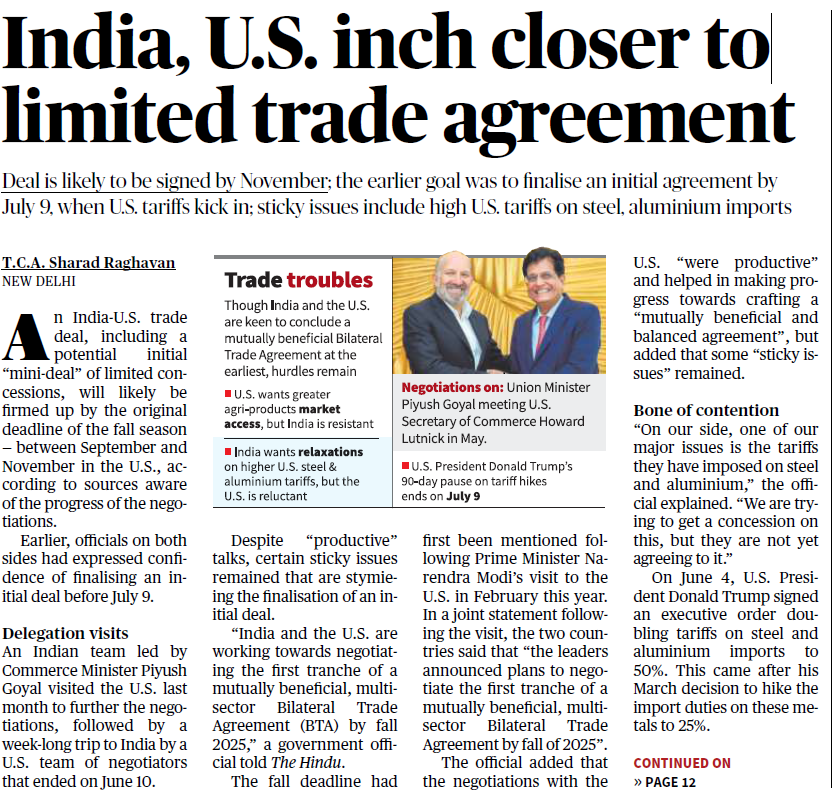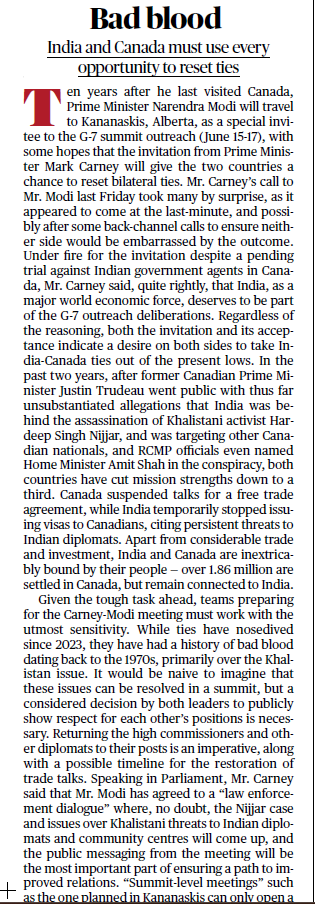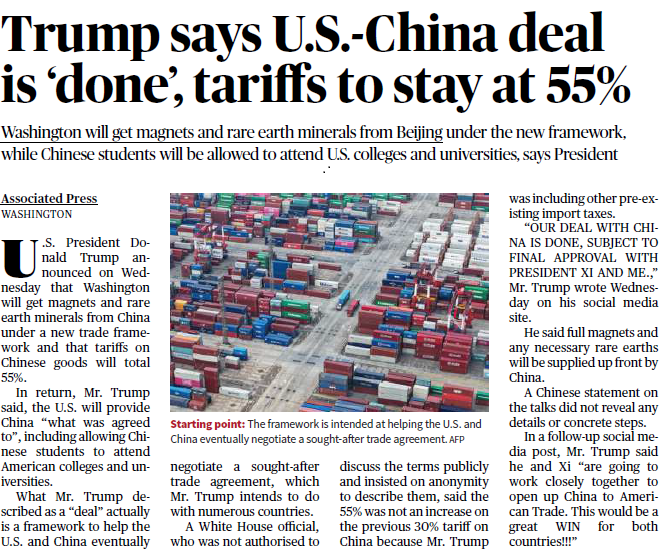 Source: The Hindu
Source: The Hindu
Relevant to: International Relations | Economy | Bilateral Trade
India and the United States are negotiating a limited trade deal, expected to be finalized between September and November 2025, aimed at addressing key tariff and market access issues
- Deal Type: A limited “mini-deal” involving concessions from both sides.
- Deadline: Original goal was July 9, 2025; new target is fall 2025 (Sep–Nov).
- Delegation: Indian delegation led by Commerce Minister Piyush Goyal visited the U.S., followed by a U.S. delegation to India.
- Sticky Issues:
- U.S. wants: Greater market access for agricultural products.
- India wants: Relaxation of high tariffs on steel and aluminum, but U.S. is reluctant.
- Tariff Update:
- On June 4, 2025, U.S. President signed an executive order to double tariffs on steel and aluminum to 50%.
- Earlier hike in March 2025 raised import duties to 25%.
Significance:
- A limited Bilateral Trade Agreement (BTA) will serve as a foundation for a comprehensive deal in the future.
- Tariff resolution could benefit Indian exporters.
- Enhances bilateral relations amidst global trade tensions.
Challenges:
- U.S. resistance to relaxing metal tariffs.
- India’s cautious stance on agricultural market access.
Implications for India:
- Opportunity to expand exports to the U.S.
- Necessity to safeguard domestic agri-sector from foreign competition.
- Potential to improve trade balance and investor confidence.
MCQ:
Q1. With reference to the India-U.S. limited trade deal being negotiated in 2025, consider the following statements:
- The U.S. seeks greater access to India’s pharmaceutical sector.
- India is seeking relaxation of U.S. tariffs on steel and aluminum.
- The deal is expected to be finalized by July 9, 2025.
Which of the above statements is/are correct?
A) 1 and 2 only
B) 2 only
C) 1 and 3 only
D) 2 and 3 only
Answer: B) 2 only
Explanation:
- Statement 1 is incorrect: The U.S. is seeking access to agri-products, not pharmaceuticals.
- Statement 2 is correct.
- Statement 3 is incorrect: The original July 9 deadline was missed; the new target is between September–November 2025.

Relevant to: Governance | Internal Security | Ethics
Source: The Hindu
Context
On June 4, 2025, a tragic stampede in Bengaluru near the M. Chinnaswamy Stadium led to the death of 11 people. The incident occurred during a celebration of RCB’s first IPL victory, highlighting serious concerns regarding public safety, governance, and accountability in managing large gatherings in India.
Lack of Crowd Management
- Poor crowd control despite predictable large gatherings at high-profile events.
- Government inaction and a lack of emergency preparedness.
Profit Over Safety
- Cricket and similar mass events are commercialized, often prioritizing profit over public safety.
- VIP culture and political pressure compromise fair allocation of safe seating and infrastructure.
Governance and Accountability Gaps
- Safety regulations exist on paper but are rarely implemented in practice.
- Event licences are granted with little real oversight or enforcement.Broader Implications
For Urban Governance
- Exposes the failure of urban safety infrastructure and non-compliance with public safety norms.
- Need for pedestrian-friendly urban planning and regulation of public gatherings.
For Ethics in Public Life
- Disregard for the value of human life in pursuit of entertainment and revenue.
- Ethical governance requires accountability, transparency, and prioritization of citizens’ safety.
For Policy Reforms
- Suggestion to introduce mandatory crowd audits before events.
- Institutionalize compensation and accountability protocols after disasters.
- Inculcate a “culture of audits” for crowd and venue management.
Recommendations for Reform
- Legal & Institutional Mechanisms:
- Mandatory risk assessment audits before granting licenses.
- Stringent penalties for negligence by event organizers or public officials.
- Infrastructure and Planning:
- Adequate entrance/exit points, safety lighting, and fire management.
- Provision for first-aid stations and trained personnel.
- Social Awareness:
- Public education on crowd behaviour and safety practices.
- Media should emphasize safety warnings, not just event hype.
MCQ:
Consider the following statements regarding public safety in India:
- Safety audits are mandatory before every large public event in India.
- VIP enclosures often get preference over common public safety in mass events.
- The lack of proper urban pedestrian infrastructure contributes to unsafe public spaces.
Which of the above statements is/are correct?
A) 1 and 2 only
B) 2 and 3 only
C) 1 and 3 only
D) 1, 2 and 3
Answer: B) 2 and 3 only
Explanation:
- Statement 1 is incorrect – Safety audits are not yet mandatory.
- Statements 2 and 3 are correct as per the editorial insights.

Source: The hindu
Relevant to: International Relations , Diaspora ,Diplomacy
Prime Minister Narendra Modi is set to visit Canada for the G-7 Outreach Summit (June 15–17, 2025) in Alberta. This visit presents a crucial opportunity to reset strained India–Canada bilateral relations, especially following tensions over allegations related to the Khalistani separatist movement.
Modi’s Visit to Canada:
- First visit in a decade.
- Attending the G-7 outreach summit on invitation by Canadian PM-designate Mark Carney.
- Seen as a diplomatic window to revive frozen bilateral dialogue.
Cause of Strain:
- 2023–2025: Canadian PM Justin Trudeau accused India of involvement in the assassination of Hardeep Singh Nijjar, a Khalistani activist.
- RCMP (Canada’s federal police) even named Indian Home Minister Amit Shah in the alleged conspiracy.
- Resulted in:
- Mutual expulsion of diplomats.
- Suspension of visa services.
- Halting of Free Trade Agreement (FTA) talks.
- Diplomatic and trade ties cut by one-third.
Diaspora Factor:
- Over 1.86 million people of Indian origin live in Canada.
- Strong cultural and emotional links between citizens.
Current Opportunity:
- Proposed “law enforcement dialogue” between both countries.
- Restoration of diplomatic positions and possible resumption of FTA talks.
- Both sides expected to publicly respect each other’s legal processes.
Significance for India:
- Geo-political leverage through re-engagement at the G-7 summit.
- Strengthening the global image of India as a mature democracy willing to address disputes.
- Supporting the Indian diaspora, who face the brunt of bilateral tensions.
- Reopening stalled economic and trade cooperation.
Challenges:
- Mistrust from recent allegations and diplomatic breakdown.
- Deep-rooted issues like Khalistani extremism in Canada.
- Politicization of diaspora groups and risk to Indian diplomats.
Way Forward:
- Use high-level summits to engage constructively.
- Prioritize institutional dialogues (e.g., law enforcement, intelligence cooperation).
- Ensure mutual respect and non-interference in internal affairs.
- Publicly reaffirm commitment to rule of law and diplomatic norms.
MCQ:
Q1. With reference to India–Canada relations in 2025, consider the following statements:
- India and Canada have completely suspended all trade agreements and diplomatic ties.
- The G-7 Outreach Summit in June 2025 is being seen as an opportunity to reset bilateral ties.
- The recent diplomatic strain was triggered by allegations related to the Khalistani movement.
Which of the above statements is/are correct?
A) 1 and 2 only
B) 2 and 3 only
C) 1 and 3 only
D) 1, 2 and 3
Answer: B) 2 and 3 only
Explanation:
- Statement 1 is incorrect: While ties were strained and partially suspended, they were not completely severed.
- Statements 2 and 3 are correct as per the article.

Source: The hindu
Relevant to: Bilateral Relations, International Trade
Former U.S. President Donald Trump announced that a new U.S.-China trade framework is finalized (“deal is done”) wherein:
- The U.S. will receive rare earth minerals and magnets from China.
- In exchange, Chinese students will be allowed to study in American universities.
- The overall tariff on Chinese goods will remain at 55%.
Deal Features:
- The deal aims to facilitate mutual economic interests.
- China will supply:
- Magnets
- Rare earth minerals (crucial for electronics, defense, and green tech)
- The U.S. will permit:
- Chinese students to pursue education in U.S. institutions.
- Other unspecified concessions termed as “what was agreed to.”
Tariff Implications:
- Tariffs on Chinese goods will remain at 55%, not reduced.
- This includes an increase from the previous 30% level.
- Trump emphasized it was not just punitive, but a means to strengthen future trade positions.
Diplomatic Statement:
- Trump noted the deal was “done,” but still awaits final approval from President Xi Jinping.
- A Chinese statement provided no additional specifics.
Significance:
For the U.S.:
- Ensures access to rare earth materials, essential for technological and defense manufacturing.
- Balances economic diplomacy with domestic protectionist policies.
For China:
- Maintains access to U.S. education for its citizens—a significant soft power tool.
- Attempts to preserve trade despite high tariffs.
Challenges:
- High tariffs may continue to strain global supply chains.
- Deal lacks transparency in mutual obligations.
- Trust deficit between the U.S. and China persists despite the framework.
Implications for India:
- Opportunity for India to strengthen its rare earth sector as a reliable alternative.
- India can benefit from diverted global supply chains.
- May reinforce the need for India to reduce dependency on Chinese imports.
MCQ:
With reference to the recent U.S.-China trade framework (2025), consider the following statements:
- The U.S. will reduce tariffs on Chinese goods from 55% to 30% as part of the agreement.
- China will supply rare earth minerals and magnets to the U.S. under the deal.
- The agreement allows Chinese students to study in U.S. universities.
Which of the statements given above is/are correct?
A) 1 and 2 only
B) 2 and 3 only
C) 1 and 3 only
D) 1, 2 and 3
Answer: B) 2 and 3 only
Explanation:
- Statement 1 is incorrect – Tariffs will remain at 55%, not reduced.
- Statements 2 and 3 are correct as per the terms of the deal.

Source: Indian express
Relevant to: Environment and Ecology
A rare Eurasian otter (Lutra lutra), previously thought to be extinct in Kashmir, has been spotted in the Lidder River, South Kashmir, reviving hopes for the species’ natural comeback and restoration of the aquatic ecosystem.
Facts:
- Scientific Name: Lutra lutra
- IUCN Status: Near Threatened
- Local Name (Kashmir): Vuder
- Sighting Location: Lidder River (Pahalgam), Gurez Valley, Herpora (Shopian)
- Last Spotted Before: Around 25–30 years ago
Ecological Role & Importance:
- Integral part of Kashmir’s aquatic ecosystem
- Carnivorous mammal feeding on fish and aquatic fauna
- Presence indicates healthy river ecosystems
Reasons for Decline:
- Water pollution
- Use of pesticides killing fish (primary food)
- Habitat destruction
- Hunting for fur
Geographical Spread:
- Found across Europe, Asia, and northern Africa
- Known to be extremely territorial
- Among the most widely distributed otter species
Recent Sightings:
- 2025: Third spotting in the year (Gurez Valley, Herpora in Shopian, Lidder River)
- Wildlife officials believe sightings indicate a stable or growing population
Conservation Implications:
- Need to protect habitats from pollution and human interference
- Encouraging for revival of aquatic biodiversity in Kashmir
- May trigger policy updates and local conservation initiatives
MCQ:
- With reference to the Eurasian Otter (Lutra lutra), consider the following statements:
- It is classified as Critically Endangered by IUCN.
- It is found only in parts of Asia and not in Europe.
- It plays a key role in maintaining the aquatic food chain.
- The Eurasian otter has been recently spotted in South Kashmir after decades.
Which of the statements given above is/are correct?
A) 1 and 2 only
B) 3 and 4 only
C) 1, 3 and 4 only
D) 2 and 4 only
Answer: B) 3 and 4 only
Explanation:
- Statement 1 is incorrect – It is Near Threatened, not Critically Endangered.
- Statement 2 is incorrect – It is found in Asia, Europe, and North Africa.
- Statement 3 is correct – It feeds on aquatic species and indicates healthy ecosystems.
- Statement 4 is correct – The article confirms a rare sighting in South Kashmir.

Source: Indian express
Relevant to: Science and Technology
The European Space Agency (ESA) released the first-ever close-up image of the Sun’s turbulent south pole, captured by the Solar Orbiter spacecraft. This milestone enhances our understanding of solar activity, the magnetic field, and the solar cycle.
Details about the Solar Orbiter Mission:
- Launched: 2020 by ESA in collaboration with NASA
- Objective: Study the Sun’s poles and heliosphere, solar magnetic field, and activity cycle
- Unique Feature: First spacecraft to observe the Sun’s poles by using a Venus gravity assist to move out of the ecliptic plane (Earth’s orbital plane)
- Instruments: Includes Polarimetric and Helioseismic Imager (PHI)
Importance of South Pole Observations:
- Solar poles are key to understanding:
- Magnetic field reversal (occurs every 11 years)
- Solar flares and coronal mass ejections
- The solar cycle, currently near its maximum (high sunspot activity)
- Helps predict solar storms which affect:
- Satellite communication
- Power grids
- Radio signals
- Space weather hazards
- Solar poles are key to understanding:
Scientific Insight:
- Solar Cycle: Lasts ~11 years, where the magnetic field flips polarity
- Data from both north and south poles will help predict the next solar minimum/maximum
- The sun’s magnetic field at the poles is currently chaotic, hinting at high solar activity
Relevance to Earth:
- Understanding the heliosphere (solar atmosphere extending beyond planets)
- Aids in preparing for space-weather events and their impact on technology and communication systems on Earth
MCQ:
- With reference to the Solar Orbiter mission, consider the following statements:
- It is a mission launched solely by the European Space Agency (ESA).
- It aims to study the Sun’s magnetic field and polar regions.
- The mission uses gravity assist from Venus to tilt out of the ecliptic plane.
- The mission is unrelated to the solar cycle.
Which of the statements given above is/are correct?
A) 1 and 2 only
B) 2 and 3 only
C) 1, 3 and 4 only
D) 2, 3 and 4 only
Answer: B) 2 and 3 only
Explanation:
- Statement 1 is incorrect – It is a joint mission by ESA and NASA.
- Statement 2 is correct – It studies solar magnetic field and polar activity.
- Statement 3 is correct – It uses Venus slingshot to achieve high-inclination orbit.
- Statement 4 is incorrect – The mission is directly linked to understanding the solar cycle.
